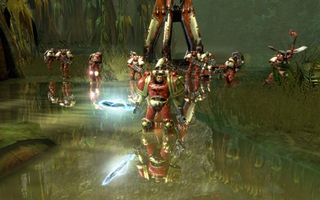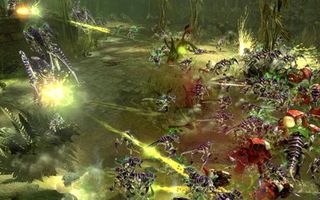There’s a splash of dust as our drop pod dents the planet’s surface, but not the kind we like. It isn’t the sort of sod we’d club out of the ground in a round of golf with an Imperial Guard Commissar. It’s less familiar, less fertile. It’s soil on steroids: populated by mutated palms and wild bushes that not only look like they could have teeth, but poor dental plans. Alien enough to unnerve average men, but then, the troops we’re left-clicking around are anything but. They’re Space Marines, and they’re printing the ground with their armored boots, unafraid of the Tyranid turf that lies ahead.

You should share their confidence – Dawn of War II looks great, as does its newly-revealed race. Relic sat us down for an in-game glance at the cast of creepy crawlers last week, but it turns out that the new gameplay mechanics are just as big of a reveal.
From our first steps out of the drop pod, Dawn of War II’s new cover system comes into effect. We’re not mousing our units through static maps that turn terrain into window-dressing, we’re using each grizzly shrub as interactive cover for our squad, a la Company of Heroes. The universal acclaim Relic received for its last RTS wasn’t lost on the dev, says the game’s Producer, Mark Noseworthy.
“Once you play an RTS where the environment is dynamic and units have a sense of self-awareness and self-preservation, there's no going back to basic ranged combat. Cover-based combat adds a tactical layer that makes everything you do on the battlefield matter.” He gives us a few examples. “Warp Spiders teleporting behind enemy lines to flank instantaneously, orbital bombardments leveling all cover on the map, and Eldar Farseers throwing up psychic shields to deflect enemy attacks are only just a taste of where we are taking the environmental tactics of Dawn of War II.”
The emphasis on strategic, active cover is a welcome one. Not only because it promotes an even pace during gameplay, but because it builds a strategic buffer for decision-making that reflects the game’s turn-based tabletop roots. Minutes in, we’re seeing it in action. We’re saddled up behind a grove, holding position to plan our attack on a Tyranid Warrior and the pack of Gaunts idling around him. They haven’t seen us yet. We click to cling to the semi-circle of flora separating us from the aliens, select a single marine, and lob a satchel charge through the brush. A timer clicks down, then blows the Tyranid lieutenant’s claws and carapace in at least six directions. The handful of leftover Gaunts go into shock (because they’re psychically separated from their superior), making them easy to mop up with our bolters. Expect these synapse-linked effects to be a trend among the Tyranids.

“Because the Tyranid swarm is a single organism spread across many disposable creatures, they have no regard for their own well-being and therefore treat the environment and their opponents differently than the humanoid races,” Noseworthy notes. “Countering the synaptic reactions will be key to defeating them. Their army is made up of many smaller, fragile creatures that protect larger powerful specialist units. These larger units can empower the smaller units and make them more effective when in the presence of these synapse creatures.”
